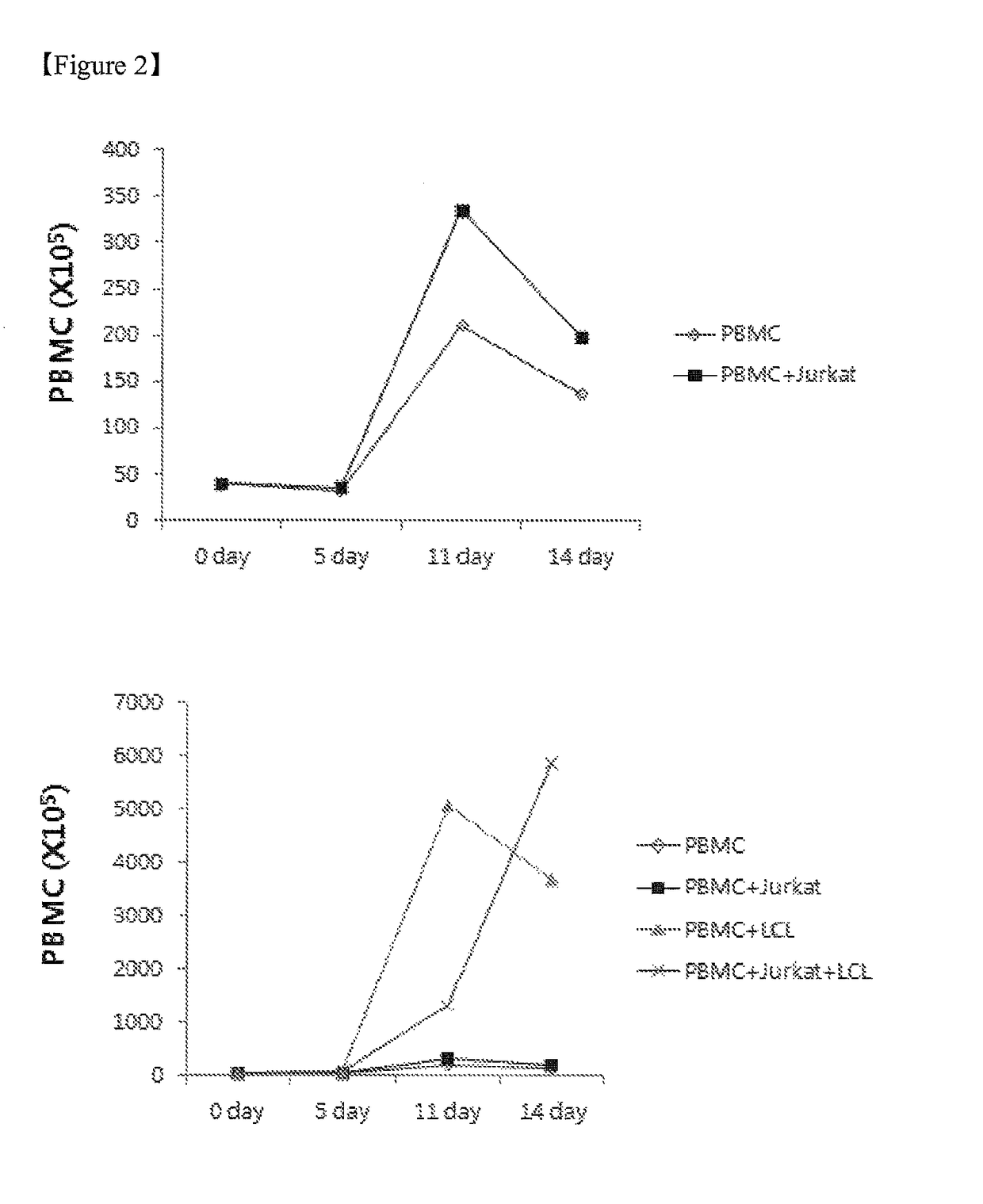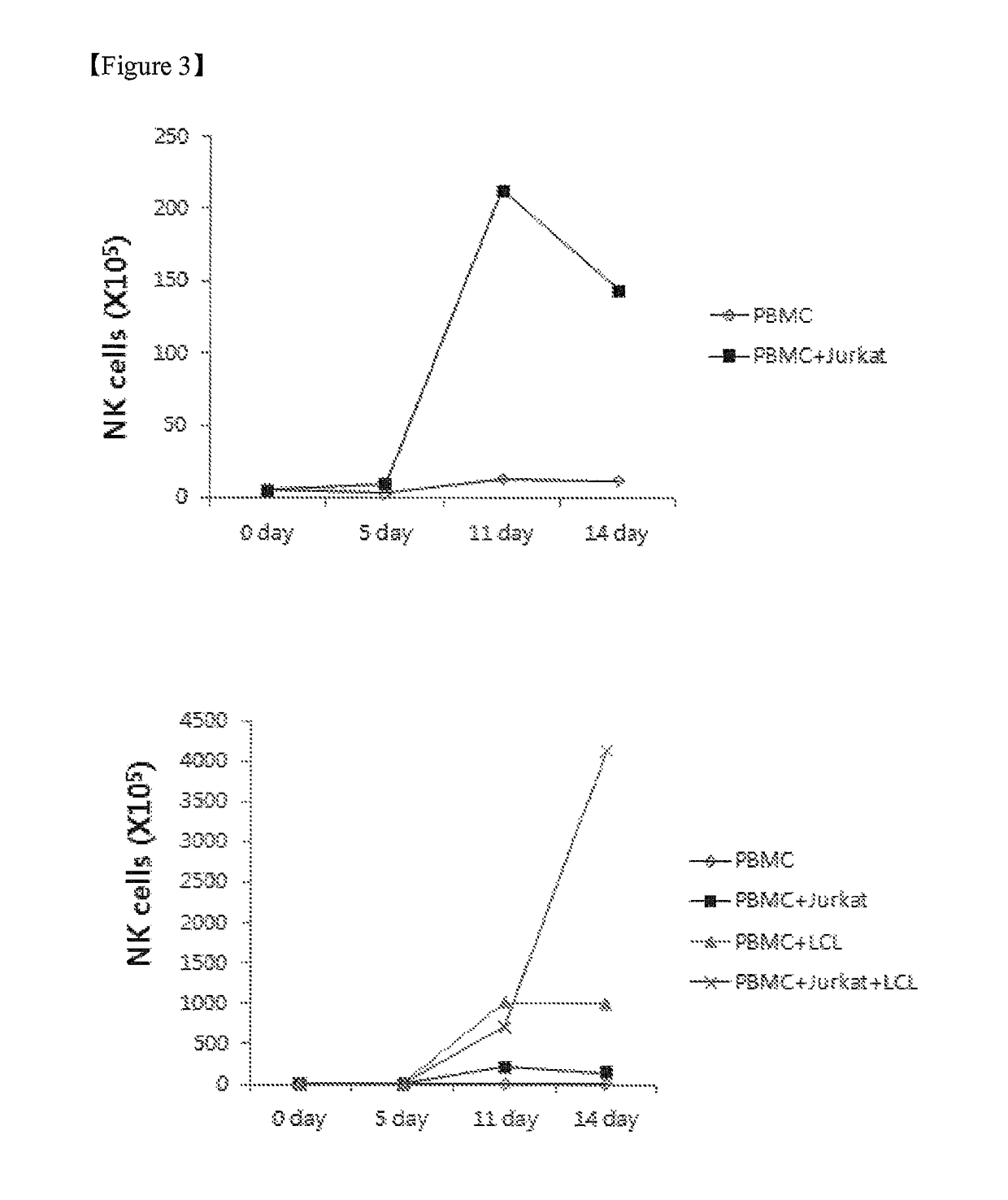Method for the induction and expansion of natural killer cells derived from peripheral blood mononuclear cells
a technology of peripheral blood mononuclear cells and natural killer cells, which is applied in the direction of tumor/cancer cells, cell culture active agents, antibody medical ingredients, etc., can solve the problems of difficult implementation, prohibitively expensive general use, and difficulty in ensuring the obtaining of a large amount of blood from cancer patients, so as to improve the efficiency and efficacy of preventing and treating cancer
- Summary
- Abstract
- Description
- Claims
- Application Information
AI Technical Summary
Benefits of technology
Problems solved by technology
Method used
Image
Examples
example 1
on of NK Cells from Peripheral Blood Mononuclear Cells
[0046]Human blood was collected and centrifuged at 2,500 rpm for 30 minutes in Ficoll (Ficoll-Paque™ PLUS, GE HealthCare), and peripheral blood mononuclear cells (PBMCs) were separated from a buffy coat. Thereafter, the PBMCs were stained with Tryphan Blue. Then, damaged cells were removed, and only unstained cells were counted using a hematocytometer.
[0047]A Jurkat cell line and an EBV-LCL cell line used as feeder cells were cultured at 37° C. in human RPMI media, which were obtained by adding 10% FBS and 1% penicillin / streptomycin to an RPMI1640 medium under a 5% CO2 condition. A hRPMI medium supplemented with 500 U / ml of IL-2 was added once every 2 to 3 days, the cells were harvested at an interval of 5 days, and a fresh hRPMI medium supplemented with IL-2 was added.
[0048]Cell counts were measured using a hematocytometer, and the Jurkat cell line and the EBV-LCL cell line, both of which were present at a concentration of 1×106...
example 2
nt of Ability to Proliferate NK Cells
[0051]To determine an effect of the feeder cells on proliferation of the NK cells, the NK cells in the experimental group defined in Example 1, control 1, control 2, and control 3 were counted on 0 day, 5th day, 11th day, and 14th day, and stained using antibodies against fluorescence-labeled CD56 and CD3. Thereafter, the NK cells were analyzed using flow cytometry to assay the groups of NK cells (CD56+, CD3−). Subsequently, the NK cells were counted using the sum of the enrichment levels of the PBMCs and NK cells.
[0052]As a result, it was revealed that the PBMCs increased approximately 147 times higher in the case of the experimental group (x, PBMC+Jurkat+LCL) in which both the Jurkat cells and the EBV-LCL cells were co-cultured with PBMCs than in the case of control 1 (⋄, PBMC), control 2 (▪, PBMC+Jurkat), or control 3 (▴, PBMC+LCL) on the 14th day of culturing, as shown in FIG. 2. Also, it was revealed that the NK cells increased approximately...
example 3
nt of Enrichment Level of NK Cells
[0053]To analyze an effect of the feeder cells and the cytokines on enrichment of the NK cells, the NK cells were stained using fluorescence-labeled CD56 and CD3 antibodies on 0 day, 5th day, 11th day, and 14th day of culturing, and analyzed for the experimental group of Example 1, control 1, control 2, and control 3 using flow cytometry. As a result, it was revealed that the percentage of the NK cell phenotypes, CD56+ and CD3 cells, increased to 70% or more when the mononuclear cells were co-cultured with the Jurkat cells and the EBV-LCL cells after the 14-day culture (FIG. 4A). FIG. 4B is a graph illustrating the enrichment levels of the NK cells, as measured on the 14th day of culturing using flow cytometry.
PUM
| Property | Measurement | Unit |
|---|---|---|
| temperature | aaaaa | aaaaa |
| fluorescence activated cell sorter | aaaaa | aaaaa |
| concentrations | aaaaa | aaaaa |
Abstract
Description
Claims
Application Information
 Login to View More
Login to View More - R&D
- Intellectual Property
- Life Sciences
- Materials
- Tech Scout
- Unparalleled Data Quality
- Higher Quality Content
- 60% Fewer Hallucinations
Browse by: Latest US Patents, China's latest patents, Technical Efficacy Thesaurus, Application Domain, Technology Topic, Popular Technical Reports.
© 2025 PatSnap. All rights reserved.Legal|Privacy policy|Modern Slavery Act Transparency Statement|Sitemap|About US| Contact US: help@patsnap.com



